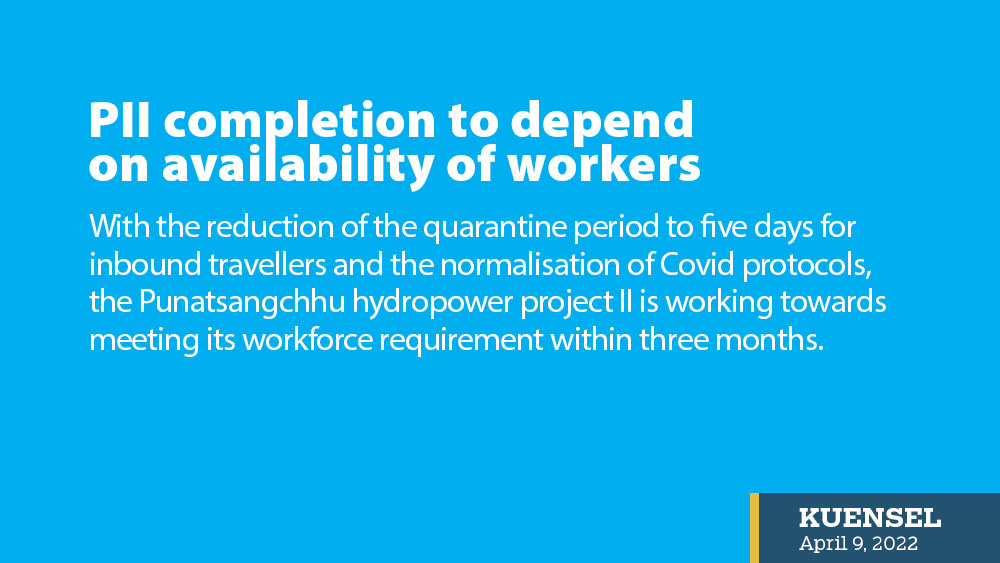MB Subba
With the reduction of the quarantine period to five days for inbound travellers and the normalisation of Covid protocols, the Punatsangchhu hydropower project II is working towards meeting its workforce requirement within three months.
The 1,020-megawatt (MW) project based in Wangdue, whose deadline for completion has been postponed to July 2022, is facing a shortage of more than 1,500 workers, according to the economic affairs minister.
The project is expected to significantly improve the ailing indicators
of the economy, which has been affected by the pandemic. The fiscal deficit has widened significantly amid a sharp decline in domestic revenue.
The economic affairs minister and chairman of the project, Lyonpo Loknath Sharma, said the project would be completed within the rescheduled timeline only if the additional workforce requirement is met within three months.
Lyonpo said that the first batch of about 100 workers are expected to arrive in Gelephu within a few days.
“While we want to import as many workers as possible to meet
the requirement, we are also cautious about the Covid risks that the community faces,” he said.
The workers, he said, would be imported in batches of 100 to 200 due to logistical issues and Covid risks. Lack of enough quarantine centres is one of the challenges of importing large numbers of workers.
He said that the import of workers would also depend on the evolving situation of the pandemic.
Other factors that could affect the work progress is the availability of cement whose demand in the project is expected to increase sharply with the increase in the workforce.
Lyonpo said that the project uses cement only from the Dungsam Cement Corporation Limited due to the quality requirement.
The annual revenue from Punatsangchhu II is estimated at Nu 17.52 billion (B).
Punatsangchhu II had achieved a 90.83 percent progress and incurred an expenditure of Nu 73.067B as of September 2021.
The 118MW Nikachhu project, which is based in Trongsa, has also been rescheduled to be completed in June 2023.
Lyonpo said that the workforce requirement was not a major issue for the Nikachhu project as the requirement was relatively small. The project
has completed more than 80 percent of the work, according to officials.
A total of Nu 10.786B was incurred in the Nikachhu project as of September 2021, according to the government.
The Nikachhu project was initially scheduled for completion in 2019. But officials cited the pandemic and geological issues for the delay.
The commissioning of the projects would not only be a major milestone in the economy but also would contribute significantly in the recovery of the economy, according to officials.
As the domestic revenue has fallen, the fiscal deficit is projected at negative 8.59 percent of GDP in the fiscal year 2021-2022.
While the projected domestic revenue in the fiscal year 2021-22 is Nu 35.6 billion (B), the recurrent expenditure for the same period is Nu 35.598B.
This means that the domestic revenue is just enough to meet the recurrent expenditure and that almost all capital activities should be funded through either borrowings or grants. The commissioning of the projects is expected to mitigate the issue to some extent.
Efforts are also being made to engage Bhutanese workers at the projects. However, skilled workers, officials said, needed to be imported.
The GDP dropped to Nu 171.57B or -10.08 percent in 2020.


